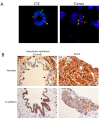Concordance of anaplastic lymphoma kinase (ALK) gene rearrangements between circulating tumor cells and tumor in non-small cell lung cancer
- PMID: 26993609
- PMCID: PMC5029624
- DOI: 10.18632/oncotarget.8136
Concordance of anaplastic lymphoma kinase (ALK) gene rearrangements between circulating tumor cells and tumor in non-small cell lung cancer
Abstract
Anaplastic lymphoma kinase (ALK) gene rearrangement in non-small cell lung cancer (NSCLC) is routinely evaluated by fluorescent in-situ hybridization (FISH) testing on biopsy tissues. Testing can be challenging however, when suitable tissue samples are unavailable. We examined the relevance of circulating tumor cells (CTC) as a surrogate for biopsy-based FISH testing. We assessed paired tumor and CTC samples from patients with ALK rearranged lung cancer (n = 14), ALK-negative lung cancer (n = 12), and healthy controls (n = 5) to derive discriminant CTC counts, and to compare ALK rearrangement patterns. Blood samples were enriched for CTCs to be used for ALK FISH testing. ALK-positive CTCs counts were higher in ALK-positive NSCLC patients (3-15 cells/1.88 mL of blood) compared with ALK-negative NSCLC patients and healthy donors (0-2 cells/1.88 mL of blood). The latter range was validated as the 'false positive' cutoff for ALK FISH testing of CTCs. ALK FISH signal patterns observed on tumor biopsies were recapitulated in CTCs in all cases. Sequential CTC counts in an index case of lung cancer with no evaluable tumor tissue treated with crizotinib showed six, three and eleven ALK-positive CTCs per 1.88 mL blood at baseline, partial response and post-progression time points, respectively. Furthermore, ALK FISH rearrangement suggestive of gene copy number increase was observed in CTCs following progression. Recapitulation of ALK rearrangement patterns in the tumor on CTCs, suggested that CTCs might be used to complement tissue-based ALK testing in NSCLC to guide ALK-targeted therapy when suitable tissue biopsy samples are unavailable for testing.
Keywords: ALK-gene rearrangement; circulating tumor cells; fluorescent in-situ hybridization; lung cancer; molecular diagnosis.
Conflict of interest statement
Chwee Teck Lim is an advisor with Clearbridge Biomedics, Singapore. Man Chun Leong is an employee of Clearbridge Biomedics, Singapore. All other authors declare that they do not have any conflicts.
Figures




Similar articles
-
Detection of circulating tumor cells harboring a unique ALK rearrangement in ALK-positive non-small-cell lung cancer.J Clin Oncol. 2013 Jun 20;31(18):2273-81. doi: 10.1200/JCO.2012.44.5932. Epub 2013 May 13. J Clin Oncol. 2013. PMID: 23669222
-
Circulating Tumor Cells with Aberrant ALK Copy Number Predict Progression-Free Survival during Crizotinib Treatment in ALK-Rearranged Non-Small Cell Lung Cancer Patients.Cancer Res. 2017 May 1;77(9):2222-2230. doi: 10.1158/0008-5472.CAN-16-3072. Cancer Res. 2017. PMID: 28461563
-
High level of chromosomal instability in circulating tumor cells of ROS1-rearranged non-small-cell lung cancer.Ann Oncol. 2015 Jul;26(7):1408-15. doi: 10.1093/annonc/mdv165. Epub 2015 Apr 6. Ann Oncol. 2015. PMID: 25846554 Free PMC article.
-
Detection of Gene Rearrangements in Circulating Tumor Cells: Examples of ALK-, ROS1-, RET-Rearrangements in Non-Small-Cell Lung Cancer and ERG-Rearrangements in Prostate Cancer.Adv Exp Med Biol. 2017;994:169-179. doi: 10.1007/978-3-319-55947-6_9. Adv Exp Med Biol. 2017. PMID: 28560674 Review.
-
Anaplastic lymphoma kinase rearrangement in lung cancer: its biological and clinical significance.Respir Investig. 2014 Nov;52(6):330-8. doi: 10.1016/j.resinv.2014.06.005. Epub 2014 Jul 30. Respir Investig. 2014. PMID: 25453376 Review.
Cited by
-
Update on liquid biopsy in clinical management of non-small cell lung cancer.Onco Targets Ther. 2019 Jul 1;12:5097-5109. doi: 10.2147/OTT.S203070. eCollection 2019. Onco Targets Ther. 2019. PMID: 31303765 Free PMC article. Review.
-
ALK Status Assessment with Liquid Biopsies of Lung Cancer Patients.Cancers (Basel). 2017 Aug 12;9(8):106. doi: 10.3390/cancers9080106. Cancers (Basel). 2017. PMID: 28805673 Free PMC article. Review.
-
Clinical utility of circulating tumor cells in patients with non-small-cell lung cancer.Transl Lung Cancer Res. 2017 Aug;6(4):486-498. doi: 10.21037/tlcr.2017.05.07. Transl Lung Cancer Res. 2017. PMID: 28904891 Free PMC article. Review.
-
Urovysion FISH Could Be Effective and Useful Method to Confirm the Identity of Cultured Circulating Tumor Cells from Bladder Cancer Patients.J Cancer. 2019 Jun 2;10(14):3259-3266. doi: 10.7150/jca.30079. eCollection 2019. J Cancer. 2019. PMID: 31289598 Free PMC article.
-
Fusion gene and splice variant analyses in liquid biopsies of lung cancer patients.Transl Lung Cancer Res. 2016 Oct;5(5):525-531. doi: 10.21037/tlcr.2016.09.02. Transl Lung Cancer Res. 2016. PMID: 27826534 Free PMC article. Review.
References
-
- American Cancer Society . Cancer Facts & Figures 2015. Atlanta: American Cancer Society; 2015. Accessed on 12 October 2015. Available from: http://www.cancer.org/research/cancerfactsstatistics/cancerfactsfigures2....
-
- Am. Cancer Soc. Atlanta: 2015. Non-small cell lung cancer survival rate by stage. Accessed on 14 March 2015. Available from: http://www.cancer.org/cancer/lungcancer-non-smallcell/detailedguide/non-....
-
- Lira ME, Kim TM, Huang D, Deng S, Koh Y, Jang B, Go H, Lee SH, Chung DH, Kim WH, Schoenmakers EFPM, Choi Y La, Park K, et al. Multiplexed gene expression and fusion transcript analysis to detect ALK fusions in lung cancer. J Mol Diagn. 2013;15:51–61. - PubMed
-
- Paez JG, Jänne PA, Lee JC, Tracy S, Greulich H, Gabriel S, Herman P, Kaye FJ, Lindeman N, Boggon TJ, Naoki K, Sasaki H, Fujii Y, et al. EGFR mutations in lung cancer: correlation with clinical response to gefitinib therapy. Science. 2004;304:1497–500. - PubMed
MeSH terms
Substances
LinkOut - more resources
Full Text Sources
Other Literature Sources
Medical

